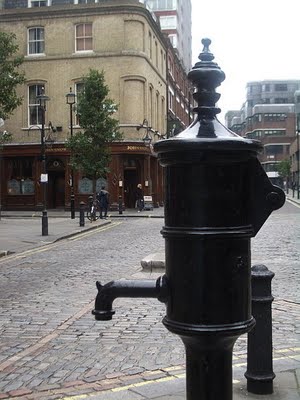THE MIASMATISTS SLEUTH SLAYER
The remarkable research behind a killer disease
It seems to be one of those strange ironies of life that those people who deserve the greatest recognition for their actions receive so little.
One such person is Dr. John Snow who discovered something literally 'lifesaving' regarding the benefits of beer, and became the father of Epidemiology.
John Snow was born on the 15th March 1813 into a rather humble upbringing, being the eldest of nine children, and a farmers son. He was, despite his station, a diligent student and the world of medicine held a great fascination for him.
Although starting out as a simple apothecary, to obtain the accredited medical qualification he so desired he begun studying at the University of London, putting down roots in Soho.
He obtained his degree in 1836 and became recognised for his burgeoning talent, and an authority on anesthesiology.
The study of cholera at this point in his life was not foremost in his thoughts, although he had come across the disease on several earlier occasions, and the interest remained fervent.
His reputation was enhanced in 1854 when he gave assistance to Queen Victoria during her birth of Prince Leopold, and the association gave him financial security for the first time.
Eventually Snow would turn his thoughts toward the question of cholera once more and begun to question the established view as to its origins.
The hardened opinion taken by many academics in the field was that cholera was caused by a 'miasma' - foul smelling air that putrefied a vicinity causing widespread death in its wake.
Snow however could nor equate the connection, as if it were the cause then there had to be evidence of lung infection, which was not the case. Instead, it attacked the bowels leading to acute bouts of diarrhoea, and then death. He reasoned that there had to be something else that was causing the illness and he turned his thoughts toward London's drinking water.
For Londoners at the time the Thames provided two important roles, one the drinking water they consumed daily, but also the excrement and waste they relieved into it. They were in effect re-consuming their own waste and Snow needed to prove that it was this that was causing the suffering.
This however would not be easy, so strong was the belief in the 'miasma' theory few would even listen to his hypothesis.
One vehement believer in miasma was The Reverend Henry Whitehead, a learned scholarly figure with an astonishing memory, who saw his role in the local community as essential to the moral fortitude of his flock.
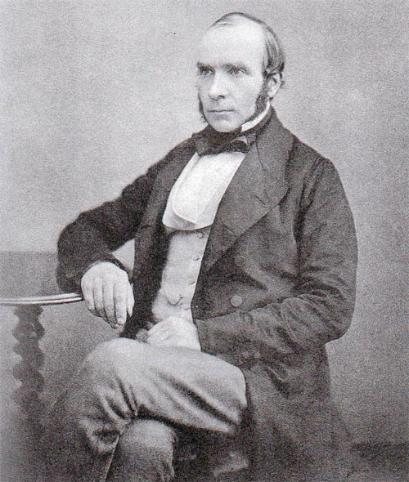
Dr. John Snow
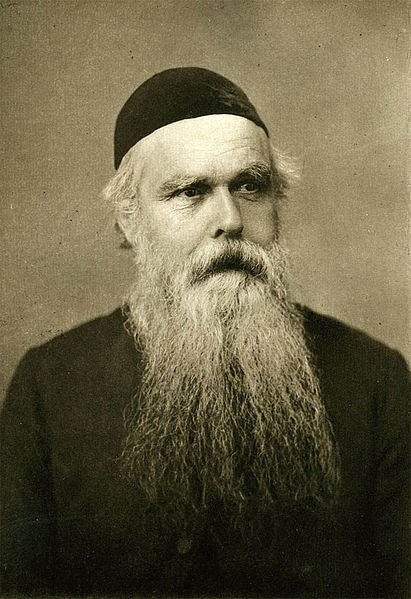
The Reverend Henry Whitehead
Whitehead's faith would be fully tested in 1854 as a new cholera epidemic would sweep through his parish of St. Lukes, and his parishioners looked to his divine inspiration to explain the terrible visitation.
Established wisdom amongst both the clergy, and the community, was that this was yet again God's wrath being metered out on the populace. Whitehead however wondered exactly what it took to appease God and unclear as to why, yet again, he vented his anger on the poorest and needy?
What Whitehead did have was comprehensive knowledge of the local inhabitants and the area, and it was this Snow would tap in to in attempting to establish his theory. Although they held very different opinions as to the cause of cholera they begun sharing information which would prove vital.
An example of their collaboration was when Snow believed he had found the index case, and cause of the outbreak, when he discovered details regarding Sarah Lewis, the mother of baby Frances, who's child had died on the 2nd September 1854.
.
Whilst this could easily have been just another cholera death Whitehead provided Snow with valuable information as he knew the family. The mother Sarah, after her daughters death, had washed Frances soiled clothing and emptied the contents into the cesspit outside her house at 40 Broad Street. It was found that the cesspit had leaked in to the water of the local Broad Street pump.
Snow begun a spot map of the area marking those houses that had contracted the fatal disease, and although a pattern was emerging, it could not be proved conclusively.
One compelling piece of information supplied to Snow via Whitehead was that a female death had occurred in Hampstead from cholera on the same day as baby Frances. Given the distance, she could not have inhaled the miasma of the area, so how did she die?
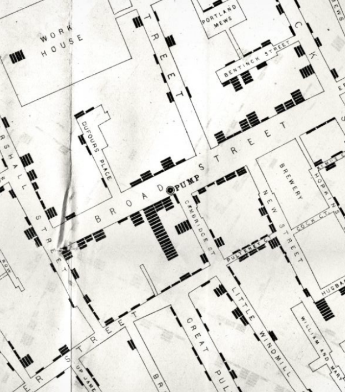
John Snow's spot map showing pump, dwellings, workhouse and brewery
Snow rode to Hampstead to investigate further and interviewed the widow's son. It transpired that his mother had once lived in Broad Street, and liked the taste of the water so much she had ordered a servant to bring back a large bottle from the pump daily. The last bottle she consumed was on collected on the 31st August - at the start of the epidemic. Furthermore, her niece who lived in Islington had also died. She too had shared the contents of the bottle with her aunt on the same day.
The overwhelming evidence (for which Whitehead was contributing) made him begin to view things in a new light, and he begun to realise that Snow's theories that cholera was in fact a water borne contagion was correct.
Further proof was also being provided once again closer to the outbreak. At the St. James's Workhouse situated at Poland Street only five of the 530 residents had contracted the illness. The workhouse had its own well which provided the inmates with drinking water and was uncontaminated
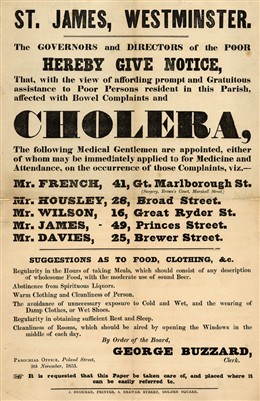
Finally, Snow made a visit to The Lion Brewery at New Street, and on interviewing the proprietor Mr. Huggins discovered that all 70 employees within the brewery had remained cholera free. It emerged that the brewery had its own well, and that the workers only consumed the beer made on the premises.
Incredibly, even in the face of such overwhelming evidence nothing was done. Political and scientific ignorance that the populace were ingesting their own waste, and dying from it, seemed just to unpalatable to confront.
It took a further outbreak in East London, and another 12 years, before Joseph Bazalgette's task of constructing the London sewage system was finally complete.
Sadly, Dr. John Snow died in June 1858 never receiving the recognition he deserved, or to see his remarkable achievements recognised. He had remarked prophetically to Whitehead:
"You and I may not live to see the day, and my name may be forgotten when it comes, but the time will arrive when great outbreaks of cholera will be things of the past; and it is the knowledge of the way in which the disease is propagated which will cause them to disappear."
--------------------------------------------------------------------------------
In memory of Dr. John Snow a replica of the Broad Street pump stands in Soho today. After his discovery both he and Whitehead persuaded the St. James's Vestry, who were responsible for the water to remove the handle. The pump and the pub (fittingly) beyond, the John Snow are testaments to his remarkable achievements.
--------------------------------------------------------------------------------
